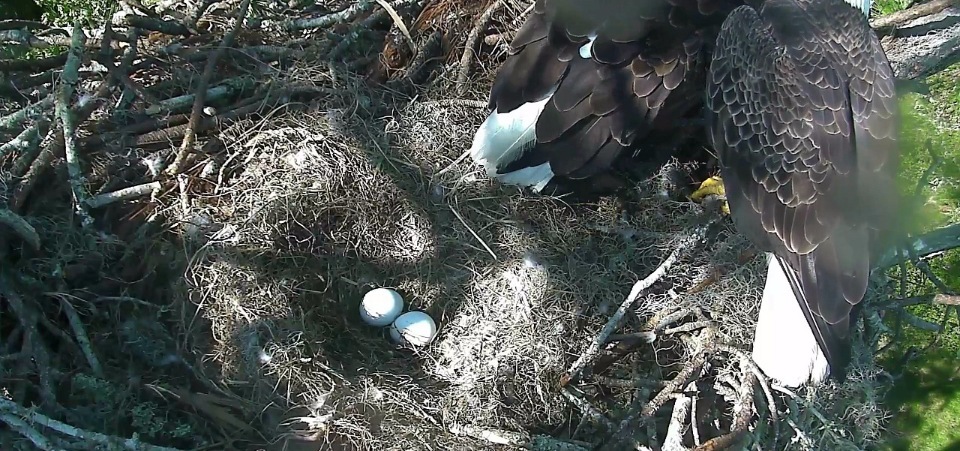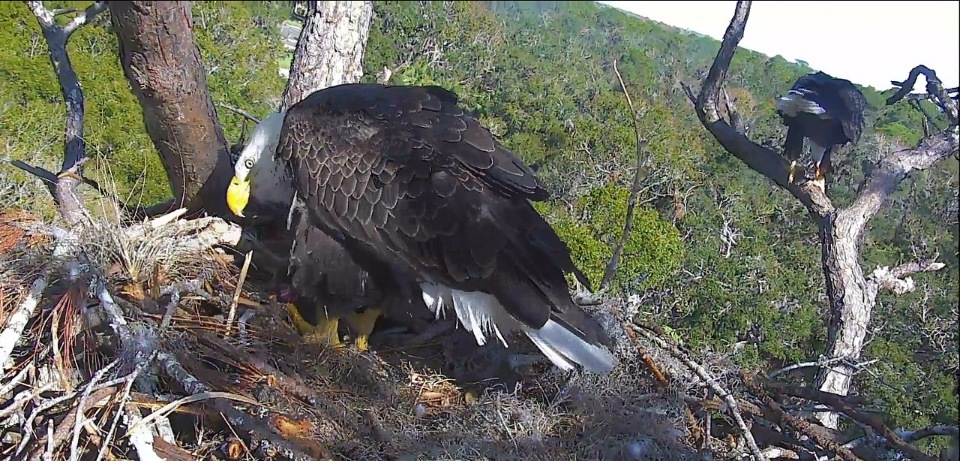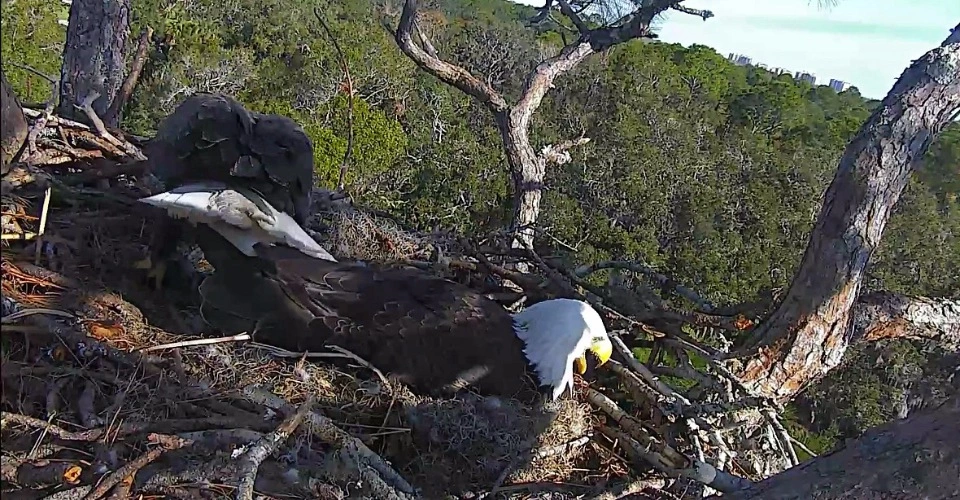12.40
Ak,šie tuvplāni tik skaisti

Un vēl tuvāk



Interesanti, vai arī mūsu bērni kopā ar vecākiem vai skolotājiem skatās ligzdas un jautā...Brophy_GWMS_NJ: So... what exactly is a pip? we know it has something to do with hatching...
sharipf_AEF: Great question and it won't be long till we see one -
sharipf_AEF: • A pip is basically a hole the eaglet makes in the shell when hatching. There are two kinds of pips: an internal pip with the chick's beak accesses the small amount of air in the chamber at the top of the egg where the chick takes its first breath. Further air filters into the chamber through the porous egg shell. From this first breath of air the chick gets a burst of energy and scratches a hole through the egg shell to the outside. This hole is called the external pip.
beach_AEF: It may tale 12-24 hours for a complete hatch.
Brophy_GWMS_NJ: wow. so technically pip watch would be for the external pip, right?
gretchen_AEF: The pip is actually the first visible sign of the hatching process.
jd_AEF: Yes, and there is great excitement when we see that pip
sharipf_AEF: We will be on pip watch in just about 2 weeks!
Brophy_GWMS_NJ: When the eggs start to hatch, do romeo and juliet continue to incubate as much as they normally would?
beach_AEF: • Yes, they will continue to incubate and even roll the egg that has not hatched. They will even sometimes roll the hatched eaglet with the unhatched egg. No worries. The eaglet will not be hurt. The babies will spend much of the next three weeks under their parents until they develop their own ability to regulate their body temperatures.
Brophy_GWMS_NJ: so cool. so how are they able to breath when under their parents?
gretchen_AEF: The parents will raise their bodies somewhat not to smother the hatchling but keep them warm
jd_AEF: we see them peeking out and it's very sweet
sharipf_AEF: The nest bowl is fairly deep and has some give to it to make enough room
gretchen_AEF: When you see the hatchlings peeking out under the parent, they look like little slippers LOL
Brophy_GWMS_NJ: that is so cute. we can't wait to see them .do the parents help the eggs hatch at all or do the babies do it all themselves?
sharipf_AEF: The parents will not help - this is the little eagles first lesson in life - how to be strong and break free by him/herself
gretchen_AEF: It is quite exhausting for the hatchling to release from the egg but necessary they do it themselves. The parents sometimes rock back and forth and that helps with the hatching process.
Brophy_GWMS_NJ: Do Eagle eggs vary in size? for example, are female eggs larger than male eggs? are they they same size from when they are laid to when they hatch?
sharipf_AEF: • Eagle eggs are the same size no matter if the eaglet is male or female. Eagle eggs are about the size of a baseball. They are white to beige in color with a matte finish. The shell is fairly thick and can take the adult weight, particularly if they are laying on a soft surface like the nest lining.
Brophy_GWMS_NJ: about the nest rails... do they build it up to make a kind of barrier to protect the babies when they are born so they don't fall out?
beach_AEF: That is exactly why they do it. When the eaglets are older, they will perch on the rails.
beach_AEF: When they begin flying many of the rails will be knocked down and the nest will look like a landing strip.
Brophy_GWMS_NJ: so cool!!!
sharipf_AEF: It makes viewers nervous when the eaglets get close to the edge!
jd_AEF: that's when we viewers get a little nervous
jd_AEF: but the eaglets have great instincts and know what they're doing
sharipf_AEF: makes me nervous too!
beach_AEF: No eaglet has fallen out of this nest since Gretchen has been watching in 2008.
gretchen_AEF: The eaglets are smart and have never fallen from this nest, tho.




Ļoti smuka pirmā bildīte 13.30, lianaliesma!lianaliesma wrote:13.30 Džuljeta tikko nomainīja Romeo. Abi sasaucas un nomaina viens otru kā pēc grāmatas...
Gan jau, ka ir gan ģimenes, gan skolotāji, kuri ar interesi seko līdzi ligzdām, Durbes ligzdai taču sekoja skolotāja ar klasi.lianaliesma wrote: Interesanti, vai arī mūsu bērni kopā ar vecākiem vai skolotājiem skatās ligzdas un jautā...
Pilnīgi piekrītu. Un kāpēc gan obligāti visiem tas jādara. Labāk, ja kāds, kuram interesē, izveido stāstījumu ar fotoattēliem, vai prezentāciju un izstāsta interesantas situācijas... būtu daudz lielāka atdeve pasākumam.d.e. wrote: Loģiskāk būtu, ja skolotāja ieteiktu katram sekot kādai online barotavai, bet nē...tas nederot.
Kaut kāds tracis beigās bija, jo loģiski, ka visi bija no interneta vilkuši gan barotavu bildes, gan putnu aprakstus.
AEF-NEFL news:
...The eagle had a left eye injury, but is able to fly and fend for itself, so we believe the eye perhaps had debris that needed to be cleared out and just a temporary issue for the bird...



Kas notiek ar olu, kad šķilšanās ir tuvu. Embrijs pozicionē savu ķermeni tā, ka tā galva atrodas apaļajā olas galā, tuvāk gaisa telpai, pārdur tā iekšējo membrānu un ieelpo savu pirmo elpu. Absorbē dzeltenumu un šķilšanās process ir tuvu sākumam. Kad čaumalas laušanas zobs (speciāls zobs — sacietējumu zoba formā, kas aug uz knābja augšējās virsmas - LL) caurdur iekšējo membrānu, gaisa šūnā atrodošā ogļskābā gāze CO2 rosina nelielas čaumalas daļas izspiešanos. Tas ir sākums, sāk ieplūst nedaudz gaisa. Tagad cālis var mazliet atpūsties.squee_AEF: What happens in the egg when hatch is near. The embryo positions its body so that its head is at the blunt end of the shell next to the air space. Pierces the inner membrane and takes its first breath. Absorbs the yolk and will soon begin the hatching process. Once the egg tooth pierces the inner shell membrane, CO2 in the air cell encourages more tapping and a small area of the shell begins to lift. This is starring, where tiny amounts of air enter.The chick may rest for a bit now.